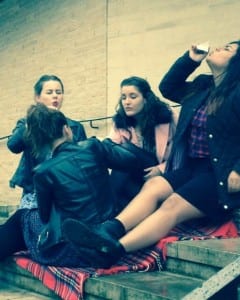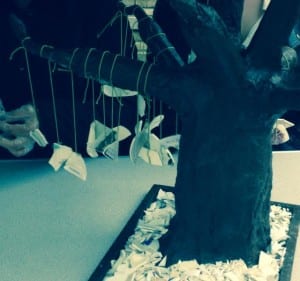Framing Statement
Mike Pearson states “site specific gives the audience a reason to pause and to stop and appreciate the space we have taken” (15, 2010). This being in the fore front of our mind we wanted our performance to cause audiences to question their surroundings of The Collection, but also examine our performance and find out the relevance it has to the site we were in. The reason we selected the space in front of the café which is between both The Collection and Usher Gallery as the basis of our performance is in relation to the crockery theme of the performance. Subsequently being placed in the middle of both the sites was appropriate. We have to the left of us is The Collection; the crockery that is placed in there is broken due to it being historical pieces, broken over time; then to the right of us is The Usher Gallery where their crockery is fine china and is intact because their pieces have been taken care of. Catherine Hughes explains “both museums and theatre present us with ourselves in different contexts, holding the mirror up and showing us what we have done and what we might do” (Hughes, 1998, 10). In my opinion I believe we had somewhat replicated this with the positioning of our performance as we, in a way, created the missing piece in a story between The Collection and The Usher Gallery. The Collection is a place for the broken crockery, where the fragments are not as important if it does not create a whole image, whilst in The Usher Gallery all of the crockery is whole and so are valuable, however, we create fragments of crockery can create something valuable and worth a place within a museum.
Analysis of Process
From a young age we are taught how to behave in public, we are trained to be; mindful, polite and acceptable. However this drilled in routine was interrupted when I was given the task to blindfold myself and be led around the Collection by a friend. “How bizarre?!” I hear you think and indeed it was! A museum is a place of peace and quiet, where you need to be mindful of your surroundings and the priceless artefacts rather than fumbling about. However this task was insightful, yet this was a very odd experience, I felt very uncomfortable and believed I was on the urge of destroying an Andy Warhol piece. I felt that I couldn’t voice my concerns and worries to my friend leading me because I would be causing too much of a scene. What I had noticed whilst completing this task was that my senses were heightened and I became aware of an airy silence that engulfed the building; it was not one of youth and joy but left me thinking of a past gone by.
The darkness made me question what art is, it made me think that maybe the darkness I was in could be considered art even though it was self-inflicted. This train of thought led me to think about our senses and what would happen if an audience were left in a dark space, how would that affect a site specific performance and audience in a museum? Being in the darkness as a theatre audience is accepted, you wait for the lights to go down to indicate a performance is going to begin however what would happen if the performance was set in the dark in a museum? Leading on to the thought of what can be created with darkness?
Polish artist Miroslaw Balka took these thoughts of darkness further and created a large chamber suspended in air, the Tate explains that audiences can either enter the chamber or “visitors can walk underneath it, listening to the echoing sound of footsteps on steel, or enter via a ramp into a pitch black interior, creating a sense of unease” (Tate, 2009). The sense of unease created in the chamber can only be an amplified version of what I personally felt in the museum being blindfolded because I did not have an intense echoing of my feet and I could also hear and feel my friend next to me as comfort, which I am sure would not be much use here. It goes on to explain the piece “intends to provide an experience for visitors which is both personal and collective, creating a range of sensory and emotional experiences through sound, contrasting light and shade, individual experience and awareness of others, perhaps provoking feelings of apprehension, excitement or intrigue.” (Tate, 2009)
The engagement I experienced with The Collection was not as intense as Balka created, I felt more inclined to try and find some support either physically like a wall or from my friend but I did not feel my senses were deprived and all I felt was fear of the darkness and of causing destruction. Site specific work is understood as a reaction to its surrounding and is a performance that will not work if it were to be moved into a different setting. The site specific performance’s development and process is heavily influenced by the site and its history and question that my group and I are going to have to ask ourselves. What is the history of The Collection? Expanding our knowledge of The Collection will mean our understanding of how the building we know today came about but also means we will be able to decipher what path we wish to take in representing The Collection, for example demonstrating how The Collection had been a home for the Usher family before it became a museum, could audiences still experience the feel of a family home or has that been lost over the years? This is a question we have to ask ourselves because as a group we need to decide on: who are seen? Who are heard? And who are represented from our performance?
The advantage of working in a museum is that there are many different aspects we can investigate and see which works best, which other groups may not have. However with every advantage you are often faced with disadvantages and there are numerous of these because we are in a museum and we will be surrounded by pieces of art, some of which are priceless and some costing amounts we can’t imagine. Not only that but we are not allowed to change the lighting within the museum there are no liquids or food permitted on site as well as no flash photography. We cannot change the temperature or use pens, only pencils are allowed. These may seem like silly requests however they all come with good reason, any flashes to a water colour painting can fade the colour, the consumption of liquids and food I think are quiet self-explanatory. Performing inside would be preferable but we have to adapt ourselves and can’t ignore that the grounds are still classed as part of the site. By solely focussing on the inside of The Collection we will be restricting ourselves on what we could achieve, working outside means we can look at the architecture of the building and grounds and examine the statues placed outside. A task was given to me to find lost and abandoned objects and to create a story behind them. Now at first I thought this was rather odd, so I went on a trek and found a cork from a wine bottle and a headband for a toy doll and this is what I came up with:
Cork – I imagined two grey haired, bearded, old drunk men walking down a cobble stoned residential street at night causing a ruckus; laughing, shouting and arguing with each other, whilst holding a bottle of wine in a brown bag that they’d just bought. They argue for a moment about who should get to drink it first, this goes on for a while until the old man holding the bottle pulls off the cork and throws it. But when it hits the floor it nearly hits a cat, which meows and runs off. This causes the old pair to laugh hysterically and carry on their way drinking as much as they can.
Toy headband – I imagine a little girl walking with her mother hand in hand. The little girl is being a little slow walking because she’s playing with her doll, while the mother is frustrated with how slow she is walking because she has an appointment to get to, a dentist appointment for her daughter. So the mother then tugs on her daughter’s hand, the daughter knocks her doll against the wall, which she was pretending was a cat walk, so the hair band the doll was wearing falls off. The little girl cries about the lost accessory but the mother ignores her and carries on dragging her to the dentist.
This task forced me to acknowledge the surroundings where I found my items and take into account every step of my journey. Once I had chosen the cork and the toy headband as my items, I had to then create a narrative for these items based on the location. Taking this idea of creating a narrative of the cork and toy head band we were able to use this technique on The Usher Gallery: Toy Headband – female doll – young girl – walking with adult – location was a residential area – probably near child’s home
This technique is what we used for our site: Museum – was James Usher’s home – an avid collector of ceramics and other items – the ceramics were examples of beautiful china – everything in his collection was beautiful to look at.
This led us to think about how the items James Usher collected were beautiful and extravagant but we asked ourselves the question: What happened to those items that were not beautiful and were not picked? The items that were not chosen then became the backbone of our performance.
Theatre and a museum in my eyes were polar opposites and then to force them to merge seemed like a disaster in my mind, theatre is loud, in your face and explosive whilst a museum is a place of knowledge, wonder and history however Susan Bennett explains that “theatres and museums have increasingly become symbolic and actual neighbours, sharing the task of providing entertaining and educational experiences that draw people” (2013, 3). I now find it unbelievable to think that I previously didn’t consider the two could mix and have one without the other which led me to reflect about how our performance will enhance our audience’s understanding of how theatre and a museum can work together and have strong similarities. The idea we have generated is: James Usher only presented beautiful and valuable items that represented his era from around the world. We would like to bring to life the unattractive and less valuable items that represent Lincoln in The Collection. For this to be carried out we would take our chosen item, the ceramics we have collected from Lincolnshire people, to break them and then to create something new that represents Lincolnshire.
All of this would be completed with audience participation from the breaking to the re-making, so it becomes the Lincoln people’s creation into The Collection, all preparation would be organised outside, with set stations for audiences to attend. However, after a discussion with our lecturer, it became clear we had to rethink certain aspects of our idea; also we did not completely understand what was expected of us. We believed we needed to repeat our performance throughout the day which was not intended, also we had to carefully think about our piece and how it was becoming more of an arts and crafts fair rather than an installation piece, baring all this in mind our original idea had to evolve as well as how we wanted to demonstrate this to our audience.
Leslie Hill and Helen Paris states “since the late 1980’s Live Art practise have become more and more concerned with the specificity of their time and place, urging audience to consider what it means to be here, now, wherever and whenever here and now maybe” (Hill and Paris, 2006, 12). Our original idea had not been asking these questions so we needed to do conceive a piece that would make the audience consider their surroundings. Our performance has changed, developed and evolved more times than I have enough fingers to count, but even though as frustrating it can be it was necessary for the evolution of the group and design. Our ideas were not developing at the rate we wanted them to and we were over analysing every aspect of the performance, so that the overall idea was hindered and was never able to grow into a performance.
This being said our final decision is:
Day 1:
Three actors will be unwrapping pre-wrapped pieces of broken ceramics and cataloguing them into the sub-groups of tea that can be created from the Camellia Sinensis plant, while the fourth actor will be over-viewing the cataloguing. Also a projection of the breaking of ceramics will be playing through the whole of this process. (The video below is what will be projected through out the day.)
(10231466, 2014)
Day 2:
In a similar style to day 1, the four actors will be taking the broken ceramics, cut green string and attach the ceramic to the string and wrap it to a pre-made tree we had created to look like the Camellia Sinensis plant. After this we then presented a mimed tea party that was heavily choreographed to the Alice in Wonderland theme tune.
The reasoning behind this idea is similar to our previous conception, in the sense of the connection with the site is the fine china; however we have expanded on this and focused on the origins of tea (the Camellia Sinensis). We bought pieces of crockery from charity shops as these are inexpensive items, unlike the crockery in The Collection, which range from fine china to historical pieces. The next step was to create a film of us smashing the pieces of crockery we bought and this will become the projection that will be played throughout day 1 and 2. The reason behind us then labelling the smashed pieces of crockery was because the pieces then became the teas that the Camellia Sinensis produces, and is the reason as to why we attached the pieces to the tree we made, as it would represent the Camellia Sinensis plant. At the end of this we then changed our costume to dresses a mimed having tea with each other on a blanket to represent the typical British style afternoon tea.
A Performance Evaluation
As a group we never considered what we had created as a performance and I believe this was reflected in how our audiences communicated with us, they became less of an audience and more curious like a child intrigued with what we were doing. This had been our intent and was what we wanted to achieve and as Mike Pearson explains in site specific performances the “audience need not be categorized, or even consider themselves, as “audience’”(2010, 175). We had wanted our audience to interact with us and question what we were doing as we wanted the audience to query their surroundings, but also ponder where the tea they were drinking came from, as they were watching us in the ‘café’. After the performance we realised that we could have expanded on the tea party at the end by having it earlier in the day and include audience participation.
Tessa Bridal explains the difference between watching a play in a theatre and a site specific performance;
“the subject matter of the play bears no relationship to the premises in which the play is performed […] [however in a museum] the subject matter is related to the museum as a whole or the exhibit” (Bridal, 2004, 9).
With this in mind we had made a decision to perform in front of the windows of the café, the reason behind this was because we would have a constant flow of audience members that can watch from the indoors if the weather was bad (which it was at times). However, as Bridal explained about the relationship between an audience member and the site, the audience members in the café were drinking their tea and watching us labelling different types of tea the Camellia Sinensis can produce, could encourage audiences to question where the tea they are drinking has come from.
Work cited:
Bridal, T (2004) Exploring Museum Theatre, Oxford: AltaMira Press.
Bennett, Susan (2013) Theatre and Museums, Basingstoke: Palgrave Macmillan.
Hill, L. and Paris, H. (2006) Performance and Place. Basingstoke: Palgrave Macmillan.
Hughes, C (1998) Museum Theatre: Communicating with Visitors Through Drama, Portsmouth: Heinemann.
Pearson, Mike (2010) site-specific performance, New York: Palgrave Macmillan.
Tate (2009) The Unilever Series: Miroslaw Balka: How It Is. [online] London: Tate. Available from http://www.tate.org.uk/whats-on/tate-modern/exhibition/unilever-series-miroslaw-balka-how-it [Accessed 24 April 2014].
The Collection Museum (2014) Art At The Collection [online] Lincoln: The Collection Museum. Available from http://www.thecollectionmuseum.com/?/visiting-us/art-at-the-collection [Accessed 31 March 2014].
Walsh, A. (2014) British Picnic [Facebook]. Available from https://scontent-a-lhr.xx.fbcdn.net/hphotos-prn2/t1.0-9/10341474_10152074660875785_8212216345792737409_n.jpg [Accessed 21 May 2014].
Walsh, A. (2014)Camelia Sinensis [Facebook]. Available from https://scontent-a-lhr.xx.fbcdn.net/hphotos-ash3/t1.0-9/10346321_10152074660705785_155164351816229187_n.jpg [Accessed 21 May 2014].
10231466. (dir.) (2014) Site Specific. [amateur film] Available from https://www.youtube.com/watch?v=LadHUSttw8A [Accessed 21 May 2014].


